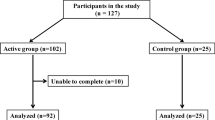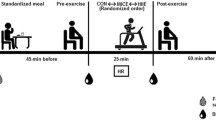Summary
The acute effects of low-intensity exercise on plasma lipids were assessed in 22 healthy, normolipidaemic volunteers [mean age (SEM) 21.1 (0.2) years] of whom 11 were untrained and 11 endurance trained. Each subject walked for 2 h on a treadmill at a speed selected to elicit 30% [29.8 (3.9)%] of his or her maximal oxygen uptake. All subjects consumed a similar diet, i.e. 48% of energy from carbohydrate, for 2 days prior to the test. Pre-exercise, high-density lipoprotein (HDL) cholesterol concentration was higher in the trained group than in the untrained group [0.88 (0.06) mmol · 1−1 vs 0.73 (0.09) mmol · 1−1,P< 0.05]. The walk elicited an increase in blood lactate concentration (P<0.01) but glucose homeostasis was well maintained by both groups. After 2 h of walking total cholesterol had increased by 13 (0.6)% (P<0.05). HDL cholesterol concentration increased by 17 (1.6)%, so that the ratio of total to HDL cholesterol was lower after the walk than pre-exercise (P<0.05). In the endurance-trained group HDL cholesterol concentration increased progressively, being 7.9 (2.4)% higher after 1 h and 19.7 (1.6)% higher after 2h. A different response was evident in the untrained group where a rise after the 1st h [25.1 (2.3)%] was followed by a decrease towards pre-exercise values. These results show that one prolonged bout of low-intensity exercise modifies lipoprotein metabolism and hold out the interesting possibility that this response may differ in trained and untrained individuals.
Similar content being viewed by others
References
Ballantyne D, Clark E, Dyker GS, Gillis GR, Hawthorne VM, Henry BA, Hole GS, Murdoch IM, Semple T, Stewart GM (1978) Prescribing exercise for the healthy: assessment of compliance and effect on plasma lipids and lipoproteins. Health Bull 32:169–175
Berg A, Johns J, Baumstark M, Kreutz W, Keul J (1983) Changes in HDL subfractions after a single, extended episode of physical exercise. Atherosclerosis 47:231–240
Bush TL, Fried LP, Barnett-Connor E (1988) Cholesterol, lipoproteins, and coronary heart disease in women. Clin Chem 34:1360–1370
Cook TC, Laporte RE, Washburn RA, Travern ND, Slemenda CW, Metz KF (1986) Chronic low level physical activity as a determinant of HDL-C and subfraction. Med Sci Sports Exerc 18:653–657
Cullinane E, Siconolfi S, Saritelli A, Thompson PD (1982) Acute decrease in serum triglycerides with exercise: is there a threshold for an exercise effect? Metabolism 31:844–847
Dill DB, Costill DL (1974) Calculation of percentage changes in volumes of blood plasma, and red cells in dehydration. J Appl Physiol 37:247–248
Durstine JL, Miller W, Farrell S, Sherman WM, Ivy JL (1983) Increases in HDL-cholesterol and the HDL/LDL cholesterol ratio during prolonged endurance exercise. Metabolism 32:993
Eisenberg S (1984) High density lipoprotein metabolism. J Lipid Res 25:1017–1058
Enger SC, Herbjornsen K, Eriksson J, Fretland A (1977) High density lipoproteins and physical activity: the influence of physical exercise, age and smoking on HDL-cholesterol and the HDL-/total cholesterol ratio. Scand J Clin Invest 37:251–255
Enger SC, Stromme SB, Refsum HE (1980) High density lipoprotein cholesterol, total cholesterol and triglycerides in serum after a single exposure to prolonged heavy exercise. Scand J Clin Lab Invest 40:341–345
Enos WF, Holmes RH, Beyer J (1953) Coronary disease among United States soldiers killed in action in Korea. JAMA 152:1090–1093
Griffin BA, Skinner ER, Maughan RJ (1988) The acute effect of prolonged walking and dietary changes on plasma lipoprotein concentrations and high-density subfractions. Metabolism 37:535–541
Hartung GH, Squires WG (1980) Exercise and high density lipoprotein cholesterol in middle-aged men. Phys Sports Med 18:74–80
Haskell WL (1984) The influence of exercise training on plasma lipids and lipoproteins in health and disease. Acta Med Scand [Suppl] 711:25–37
Jacobs I, Lithell H, Karlsson J (1982) Dietary effects on glycogen and lipoprotein lipase activity in skeletal muscle in man. Acta Physiol Scand 115:85–90
Kiens B, Lithell G (1989) Lipoprotein metabolism influenced by training induced changes in human skeletal muscle. J Clin Invest 83:558–564
Lennon DLF, Stratman FW, Shrago E, Nagle FJ, Hanson PG, Maddon M, Spennetta T (1983) Total cholesterol and HDL cholesterol changes during acute, moderate intensity exercise in men and women. Metabolism 32:486–488
Lithell H, Schele R, Vessby B, Jacobs J (1984) Lipoprotein lipase and glycogen after prolonged physical activity. J Appl Physiol 57:698–702
Maughan RJ (1982) A simple, rapid method for the detection of glucose, lactate, pyruvate, alanine, 3-hydroxybutyrate and acetoacetate on a single 20 μl blood sample. Clin Chim Acta 122:231–240
Miller GJ, Miller NE (1975) Plasma high density lipoprotein concentration and development of ischaemic heart disease. Lancet 1:16–19
Moll ME, Williams RS, Lester RM, Quarfordt SH, Wallace AG (1979) Cholesterol metabolism in non-obese women. Atherosclerosis 34:159–166
Morris JN, Clayton DG, Everitt MG, Semmence AM, Burgess EH (1990) Exercise in leisure time; coronary attack and death rates. Br Heart J 63:325–334
Nikkila EA, Taskinen MR, Rehunen S, Harkonen M (1978) Lipoprotein lipase activity in adipose tissue and skeletal muscle of runners: relation to serum lipoproteins. Metab Clin Exp 27:1661–1671
Olivecrona T, Bengtsson-Olivecrona G (1990) Lipoprotein lipase and hepatic lipase. Curr Opin Lipidol 1:222–230
Paffenbarger RS, Wing AL, Hyde RT (1978) Physical activity as an index of heart attack risk in college alumni. N Engl J Med 314:605–613
Paul AA, Southgate DAT (1988) McCance and Widdowson's The composition of foods, 4th edn. Her Majesty's Stationery Office. Elsevier, Amsterdam
Powell KE, Thompson PD, Casperson CJ, Kendrick JS (1987) Physical activity and the incidence of coronary heart disease. Annu Rev Publ Health 8:252–287
Skinner ER, Black D, Maughan RJ (1985) Variability in the response of different male subjects to the effect of marathon running on the increase in plasma high density lipoprotein. Eur J Appl Physiol 54:488–493
Thorland WG, Gilliam TB (1981) Comparison of serum lipids between habitually high and low active pre-adolescent males. Med Sci Sports Exerc 13:316–321
Walker M (1986) Dietary planning for performance. Nutrition in sport. Shaklee, Milton Keynes
Williams PT, Krauss RM, Wood PD, Lindgren FT, Giotus C, Vranizan KM (1986) Lipoprotein subfractions of runners and sedentary men. Metabolism 35:45–52
Wood PD, Haskell W (1979) The effect of exercise on plasma high density lipoproteins. Lipids 14:417–427
Author information
Authors and Affiliations
Rights and permissions
About this article
Cite this article
Pay, H.E., Hardman, A.E., Jones, G.J.W. et al. The acute effects of low-intensity exercise on plasma lipids in endurance-trained and untrained young adults. Europ. J. Appl. Physiol. 64, 182–186 (1992). https://doi.org/10.1007/BF00717958
Accepted:
Issue Date:
DOI: https://doi.org/10.1007/BF00717958




